Natural Dyes and Their Derivatives Integrated into Organic Solar Cells
Abstract
1. Introduction
2. As Extracted Natural Dyes in OSC Active Layers
3. Efficient OSCs Employing Natural Dye Derivatives or Synthetic Equivalents as Active Materials
4. OSCs with Natural Complexes as Light-Harvesting Interlayers
5. Conclusions
Funding
Acknowledgments
Conflicts of Interest
References
- Xue, R.; Zhang, J.; Li, Y.; Li, Y. Organic solar cell materials toward commercialization. Small 2018, 14, 1801793. [Google Scholar] [CrossRef] [PubMed]
- Upama, M.B.; Wright, M.; Elumalai, N.K.; Mahmud, M.A.; Wang, D.; Xu, C.; Uddin, A. High-efficiency semitransparent organic solar cells with non-fullerene acceptor for window application. ACS Photonics 2017, 4, 2327–2334. [Google Scholar] [CrossRef]
- Vohra, V. Can polymer solar cells open the path to sustainable and efficient photovoltaic windows fabrication? Chem. Rec. 2018, in press. [Google Scholar] [CrossRef] [PubMed]
- O’Connor, T.F.; Zaretski, A.V.; Savagatrup, S.; Printz, A.D.; Wilkes, C.D.; Diaz, M.I.; Sawyer, E.J.; Lipomi, D.J. Wearable organic solar cells with high cyclic bending stability: Materials selection criteria. Sol. Energy Mater. Sol. Cells 2016, 144, 438–444. [Google Scholar] [CrossRef]
- Vohra, V.; Kawashima, K.; Kakara, T.; Koganezawa, T.; Osaka, I.; Takimiya, K.; Murata, H. Efficient inverted polymer solar cells employing favourable molecular orientation. Nat. Photonics 2015, 9, 403–408. [Google Scholar] [CrossRef]
- Zhang, S.; Qin, Y.; Zhu, J.; Hou, J. Over 14% efficiency in polymer solar cells enabled by a chlorinated polymer donor. Adv. Mater. 2018, 30, 1800868. [Google Scholar] [CrossRef] [PubMed]
- Hug, H.; Barder, M.; Mair, P.; Glatzel, T. Biophotovoltaics: Natural pigments in dye-sensitized solar cells. Appl. Energy 2014, 115, 216–225. [Google Scholar] [CrossRef]
- Ravi, S.K.; Udayagiri, V.S.; Suresh, L.; Tan, S.C. Emerging role of the band-structure approach in biohybrid photovoltaics: A path beyond bioelectrochemistry. Adv. Funct. Mater. 2018, 28, 1705305. [Google Scholar] [CrossRef]
- Yakuphanoglu, F.; Aydin, M.; Kiliçoǧlu, T. Photovoltaic properties of Au/β-carotene/n-Si organic solar cells. J. Phys. Chem. B 2006, 110, 9782–9784. [Google Scholar] [CrossRef] [PubMed]
- Tang, C.W.; Albrecht, A.C. Chlorophyll-a photovoltaic cells. Nature 1975, 254, 507–509. [Google Scholar] [CrossRef]
- Dodelet, J.P.; Brich, J.L.; Leblanc, R. Photovoltaic efficiencies of microcrystalline and anhydrous chlorophyll a. Photochem. Photobiol. 1979, 29, 1135–1145. [Google Scholar] [CrossRef]
- Uehara, K.; Takagishi, K.; Tanaka, M. The Al/Indigo/Au photovoltaic cell. Sol. Cells 1987, 22, 295–301. [Google Scholar] [CrossRef]
- Frolov, L.; Wilner, O.; Carmeli, C.; Carmeli, I. Fabrication of oriented multilayers of photosystem I proteinson solid surfaces by auto-metallization. Adv. Mater. 2008, 20, 263–266. [Google Scholar] [CrossRef]
- Saenger, W.; Jordan, P.; Krauß, N. The assembly of protein subunits and cofactors in photosystem I. Curr. Opin. Struct. Biol. 2002, 12, 244–254. [Google Scholar] [CrossRef]
- Sutikno, M.; Dharmaputera, N.M.; Rahayu, S. Fabrication and characterization of banana flower extract anthocyanin-based organic solar cell. J. Adv. Agric. Technol. 2014, 1, 89–93. [Google Scholar] [CrossRef]
- Laily, A.R.N.; Hasiah, S.; Nik Aziz, N.A.; Dagang, A.N. Poly (3-dodecylthiophene)/natural dye bulk heterojunction organic solar cell: An electrical conductivity, and hall effect study. Procedia Chem. 2016, 19, 2–9. [Google Scholar] [CrossRef]
- Sabio, E.; Lozano, M.; Montero de Espinosa, V.; Mendes, R.L.; Pereira, A.P.; Palavra, A.F.; Coelho, J.A. Lycopene and β-carotene extraction from tomato processing waste using supercritical CO2. Ind. Eng. Chem. Res. 2003, 42, 6641–6646. [Google Scholar] [CrossRef]
- Chemat-Djenni, Z.; Ferhat, M.A.; Tomao, V.; Chemat, F. Carotenoid extraction from tomato using a green solvent resulting from orange processing waste. J. Essent. Oil Bear. Pl. 2010, 13, 139–147. [Google Scholar] [CrossRef]
- Kanda, H.; Kamo, Y.; Machmudah, S.; Wahyudiono, E.Y.; Goto, M. Extraction of fucoxanthin from raw macroalgae excluding drying and cell wall disruption by liquefied dimethyl ether. Mar. Drugs 2014, 12, 2383–2396. [Google Scholar] [CrossRef] [PubMed]
- Wang, X.-F.; Wang, L.; Wang, Z.; Wang, Y.; Tamai, N.; Hong, Z.; Kido, J. Natural photosynthetic carotenoids for solution-processed organic bulk-heterojunction solar cells. J. Phys. Chem. C 2013, 117, 804–811. [Google Scholar] [CrossRef]
- Dang, M.T.; Hirsch, L.; Wantz, G. P3HT:PCBM, best seller in polymer photovoltaic research. Adv. Mater. 2011, 23, 3597–3602. [Google Scholar] [CrossRef] [PubMed]
- Zhuang, T.; Sasaki, S.; Ikeuchi, T.; Kido, J.; Wang, X.-F. Natural-photosynthesis-inspired photovoltaic cells using carotenoid aggregates as electron donors and chlorophyll derivatives as electron acceptors. RSC Adv. 2015, 5, 45755–45759. [Google Scholar] [CrossRef]
- Tange, R.; Inai, K.; Sagawa, T.; Yoshikawa, S. Application of self-assembling photosynthetic dye for organic photovoltaics. J. Mater. Res. 2011, 26, 306–310. [Google Scholar] [CrossRef]
- Yun, J.-J.; Jung, H.-S.; Kim, S.-H.; Han, E.-M.; Vaithianathan, V.; Jenekhe, S.A. Chlorophyll-layer-inserted poly(3-hexyl-thiophene) solar cell having a high light-to-current conversion efficiency up to 1.48%. Appl. Phys. Lett. 2005, 87, 123102. [Google Scholar] [CrossRef]
- Xu, H.; Zhang, R.; Ma, S.; Qu, Z.; Zhang, X.; Zhang, Q. Theoretical studies on the mechanism of primary electron transfer in thephotosynthetic reaction center of Rhodobacter sphaeroides. Photosynth. Res. 2002, 74, 11–36. [Google Scholar] [CrossRef] [PubMed]
- Mustain, M.; Sulistyana, D.; Utari, U.; Purnama, B. Charge carrier mobility analysis of chlorophyll thin film spirulinasp produced by spin coating. Indonesian J. Appl. Phys. 2016, 4, 14–18. [Google Scholar] [CrossRef]
- Brettel, K.; Leibl, W. Electron transfer in photosystem I. Biochim. Biophys. Acta Bioenergy 2001, 1507, 100–114. [Google Scholar] [CrossRef]
- Kazemzadeh, S.; Riazi, G.; Ajeian, R. Novel approach of biophotovoltaic solid state solar cells based on a multilayer of PS1 complexes as an active layer. ACS Sustain. Chem. Eng. 2017, 5, 9836–9840. [Google Scholar] [CrossRef]
- Zeynali, A.; Ghiasi, T.S.; Riazi, G.; Ajeian, R. Organic solar cell based on photosystem I pigment-protein complex, fabrication and optimization. Org. Electron. 2017, 51, 341–348. [Google Scholar] [CrossRef]
- Das, R.; Kiley, P.J.; Segal, M.; Norville, J.; Yu, A.A.; Wang, L.; Trammell, S.A.; Reddick, L.E.; Kumar, R.; Stellacci, F.; et al. Integration of photosynthetic protein molecular complexes in solid-state electronic devices. Nano Lett. 2004, 4, 1079–1083. [Google Scholar] [CrossRef]
- Morvillo, P.; Ricciardi, R.; Nenna, G.; Bobeico, E.; Diana, R.; Minarini, C. Elucidating the origin of the improved current output in inverted polymer solar cells. Sol. Energy Mater. Sol. Cells 2016, 152, 51–58. [Google Scholar] [CrossRef]
- Gordiichuk, P.I.; Wetzelaer, G.A.H.; Rimmerman, D.; Gruszka, A.; De Vries, J.W.; Saller, M.; Gautier, D.A.; Catarci, S.; Pesce, D.; Richter, S.; et al. Solid-state biophotovoltaic cells containing photosystem I. Adv. Mater. 2014, 26, 4863–4869. [Google Scholar] [CrossRef] [PubMed]
- Wang, Y.-W.; Sasaki, S.; Zhuang, T.; Tamiaki, H.; Zhang, J.-P.; Ikeuchi, T.; Hong, Z.; Kido, J.; Wang, X.-F. Dicyano-functionalized chlorophyll derivatives with ambipolar characteristic for organic photovoltaics. Org. Electron. 2013, 14, 1972–1979. [Google Scholar] [CrossRef]
- Duan, S.; Chen, G.; Li, M.; Chen, G.; Wang, X.-F.; Tamiaki, H.; Sasaki, S. Near-infrared absorption bacteriochlorophyll derivatives as biomaterial electron donor for organic solar cells. J. Photochem. Photobiol. A Chem. 2017, 347, 49–54. [Google Scholar] [CrossRef]
- Duan, S.; Dall’Agnese, C.; Chen, G.; Wang, X.-F.; Tamiaki, H.; Yamamoto, Y.; Ikeuchi, T.; Sasaki, S. Bilayer chlorophyll-based biosolar cells inspired from the Z-scheme process of oxygenic photosynthesis. ACS Energy Lett. 2018, 3, 1708–1712. [Google Scholar] [CrossRef]
- Głowacki, E.D.; Voss, G.; Sariciftci, N.S. 25th anniversary article: progress in chemistry and applications of functional indigos for organic electronics. Adv. Mater. 2013, 25, 6783–6800. [Google Scholar] [CrossRef] [PubMed]
- Irimia-Vladu, M.; Głowacki, E.D.; Troshin, P.A.; Schwabegger, G.; Leonat, L.; Susarova, D.K.; Krystal, O.; Ullah, M.; Kanbur, Y.; Bodea, M.A.; et al. Indigo—A natural pigment for high performance ambipolar organic field effect transistors and circuits. Adv. Mater. 2012, 24, 375–380. [Google Scholar] [CrossRef] [PubMed]
- Głowacki, E.D.; Voss, G.; Demirak, K.; Havlicek, M.; Sünger, N.; Okur, A.C.; Monkowius, U.; Gąsiorowski, J.; Leonat, L.; Sariciftci, N.S. A facile protection–deprotection route for obtainingindigo pigments as thin films and their applications inorganic bulk heterojunctions. Chem. Commun. 2013, 49, 6063–6065. [Google Scholar] [CrossRef] [PubMed]
- Stalder, R.; Mei, J.; Subbiah, J.; Grand, C.; Estrada, L.A.; So, F.; Reynolds, J.R. N-type conjugated polyisoindigos. Macromolecules 2011, 44, 6303–6310. [Google Scholar] [CrossRef]
- Mei, J.; Graham, K.R.; Stalder, R.; Reynolds, J.R. Synthesis of isoindigo-based oligothiophenes for molecular bulk heterojunction solar cells. Org. Lett. 2010, 12, 660–663. [Google Scholar] [CrossRef] [PubMed]
- Sonar, P.; Tan, H.-S.; Sun, S.; Lam, Y.M.; Dodabalapur, A. Isoindigo dye incorporated copolymers with naphthalene and anthracene: Promising materials for stable organic field effect transistors. Polym. Chem. 2013, 4, 1983–1994. [Google Scholar] [CrossRef]
- Wang, E.; Ma, Z.; Zhang, Z.; Henriksson, P.; Inganäs, O.; Zhang, F.; Andersson, M.R. An isoindigo-based low band gap polymer for efficient polymer solar cells with high photo-voltage. Chem. Commun. 2011, 47, 4908–4910. [Google Scholar] [CrossRef] [PubMed]
- Tegegne, N.A.; Abdissa, Z.; Mammo, W.; Andersson, M.R.; Schlettwein, D.; Schwoerer, H. Ultrafast excited state dynamics of a bithiophene-isoindigo copolymer obtained by direct arylation polycondensation and its application in indium tin oxide-free solar cells. J. Polym. Sci. Part B Polym. Phys. 2018, 56, 1475–1483. [Google Scholar] [CrossRef]
- Stadler, R.; Grand, C.; Subbiah, J.; So, F.; Reynolds, J.R. An isoindigo and dithieno[3,2-b:2’,3’-d]silole copolymer for polymer solar cells. Polym. Chem. 2012, 3, 89–92. [Google Scholar] [CrossRef]
- Ma, Z.; Wang, E.; Jarvid, M.A.; Henriksson, P.; Inganäs, O.; Zhang, F.; Andersson, M.R. Synthesis and characterization of benzodithiophene–isoindigo polymers for solar cells. J. Mater. Chem. 2012, 22, 2306–2314. [Google Scholar] [CrossRef]
- Wang, E.; Ma, Z.; Zhang, Z.; Vandewal, K.; Henriksson, P.; Inganäs, O.; Zhang, F.; Andersson, M.R. An easily accessible isoindigo-based polymer for high-performance polymer solar cells. J. Am. Chem. Soc. 2011, 133, 14244–14247. [Google Scholar] [CrossRef] [PubMed]
- Ma, Z.; Dang, D.; Tang, Z.; Gedefaw, D.; Bergqvist, J.; Zhu, W.; Mammo, W.; Andersson, M.R.; Inganäs, O.; Zhang, F.; et al. A facile method to enhance photovoltaic performance of benzodithiophene-isoindigo polymers by inserting bithiophene spacer. Adv. Energy Mater. 2014, 4, 1301455. [Google Scholar] [CrossRef]
- Zhu, L.; Jiang, C.; Chen, G.; Zhou, Z.; Li, Q. Side chain engineering: The effect on the properties of isoindigo-based conjugated polymers contain different length and structure alkyl chains on nitrogen atom. Org. Electron. 2017, 49, 278–285. [Google Scholar] [CrossRef]
- Zhu, L.; Wang, M.; Li, B.; Jiang, C.; Li, Q. High efficiency organic photovoltaic devices based on isoindigo conjugated polymers with a thieno[3,2-b]thiophene π-bridge. J. Mater. Chem. A 2016, 4, 16064–16072. [Google Scholar] [CrossRef]
- Xu, T.; Yu, L. How to design low bandgap polymers for highly efficient organic solar cells. Mater. Today 2014, 17, 11–15. [Google Scholar] [CrossRef]
- Liu, X.; Liu, C.; Sun, R.; Liu, K.; Zhang, Y.; Wang, H.-Q.; Fang, J.; Yang, C. Improved device performance of polymer solar cells by using a thin light-harvesting-complex modified ZnO film as the cathode interlayer. ACS Appl. Mater. Interfaces 2015, 7, 18904–18908. [Google Scholar] [CrossRef] [PubMed]
- Lu, L.; Kelly, M.A.; You, W.; Yu, L. Status and prospects for ternary organic photovoltaics. Nat. Photonics 2015, 9, 491–500. [Google Scholar] [CrossRef]
- An, Q.; Zhang, F.; Zhang, J.; Tang, W.; Deng, Z.; Hu, B. Versatile ternary organic solar cells: A critical review. Energy Environ. Sci. 2016, 9, 281–322. [Google Scholar] [CrossRef]
- Yao, K.; Liu, C.; Chen, Y.; Chen, L.; Li, F.; Liu, K.; Sun, R.; Wang, P.; Yang, C. Integration of light-harvesting complexes into the polymer bulk heterojunction P3HT/PCBM device for efficient photovoltaic cells. J. Mater. Chem. 2012, 22, 7342–7349. [Google Scholar] [CrossRef]
- Yao, K.; Jiao, H.; Yu, Y.-X.; He, Q.; Li, F.; Wang, X. Nano-bio hybrids of plasmonic metals/photosynthetic proteins for broad-band light absorption enhancement in organic solar cells. J. Mater. Chem. A 2016, 4, 13400–13406. [Google Scholar] [CrossRef]
- Nakano, K.; Suzuki, K.; Chen, Y.; Tajima, K. Roles of energy/charge cascades and intermixed layers at donor/acceptor interfaces in organic solar cells. Sci. Rep. 2016, 6, 29529. [Google Scholar] [CrossRef] [PubMed]
- Cho, S.; Kim, K.-D.; Heo, J.; Lee, J.Y.; Cha, G.; Seo, B.Y.; Kim, Y.D.; Kim, Y.S.; Choi, S.-Y.; Lim, D.C. Role of additional PCBM layer between ZnO and photoactive layers in inverted bulk heterojunction solar cells. Sci. Rep. 2014, 4, 4306. [Google Scholar] [CrossRef] [PubMed]
- Oh, Y.; Lim, J.W.; Kim, J.G.; Wang, H.; Kang, B.-H.; Park, Y.W.; Kim, H.; Jang, Y.J.; Kim, J.; Kim, D.H.; et al. Plasmonic periodic nanodot arrays via laser interference lithography for organic photovoltaic cells with >10% efficiency. ACS Nano 2016, 10, 10143–10151. [Google Scholar] [CrossRef] [PubMed]

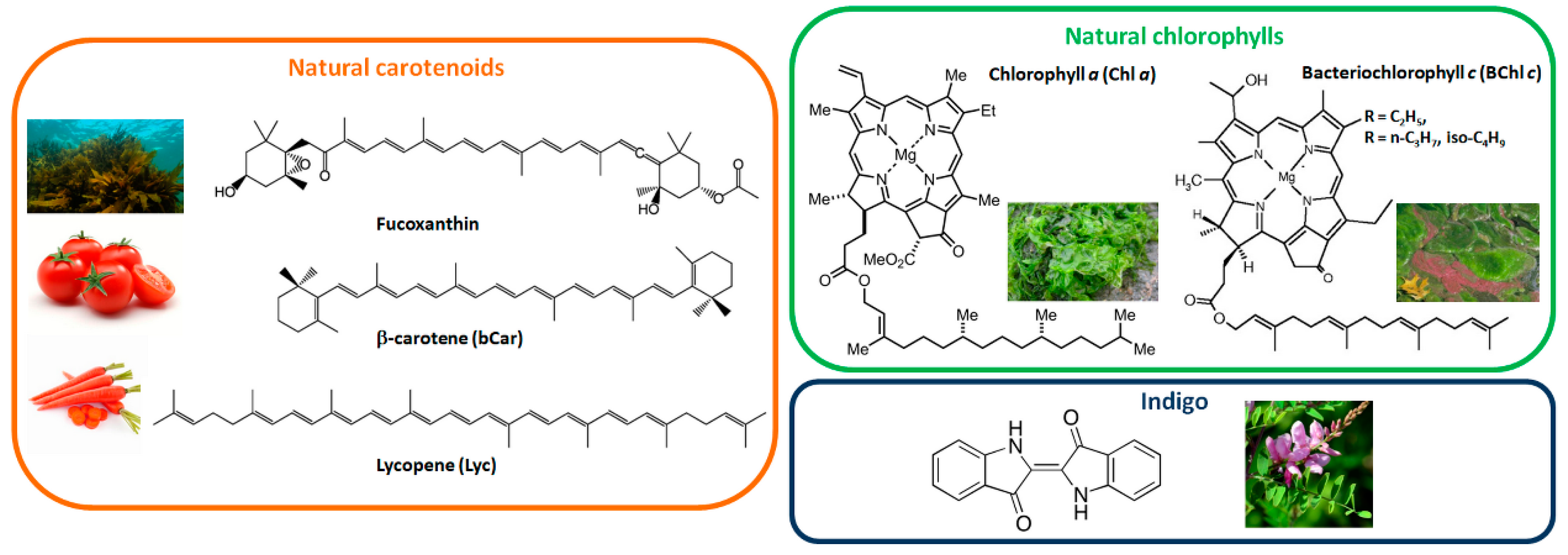
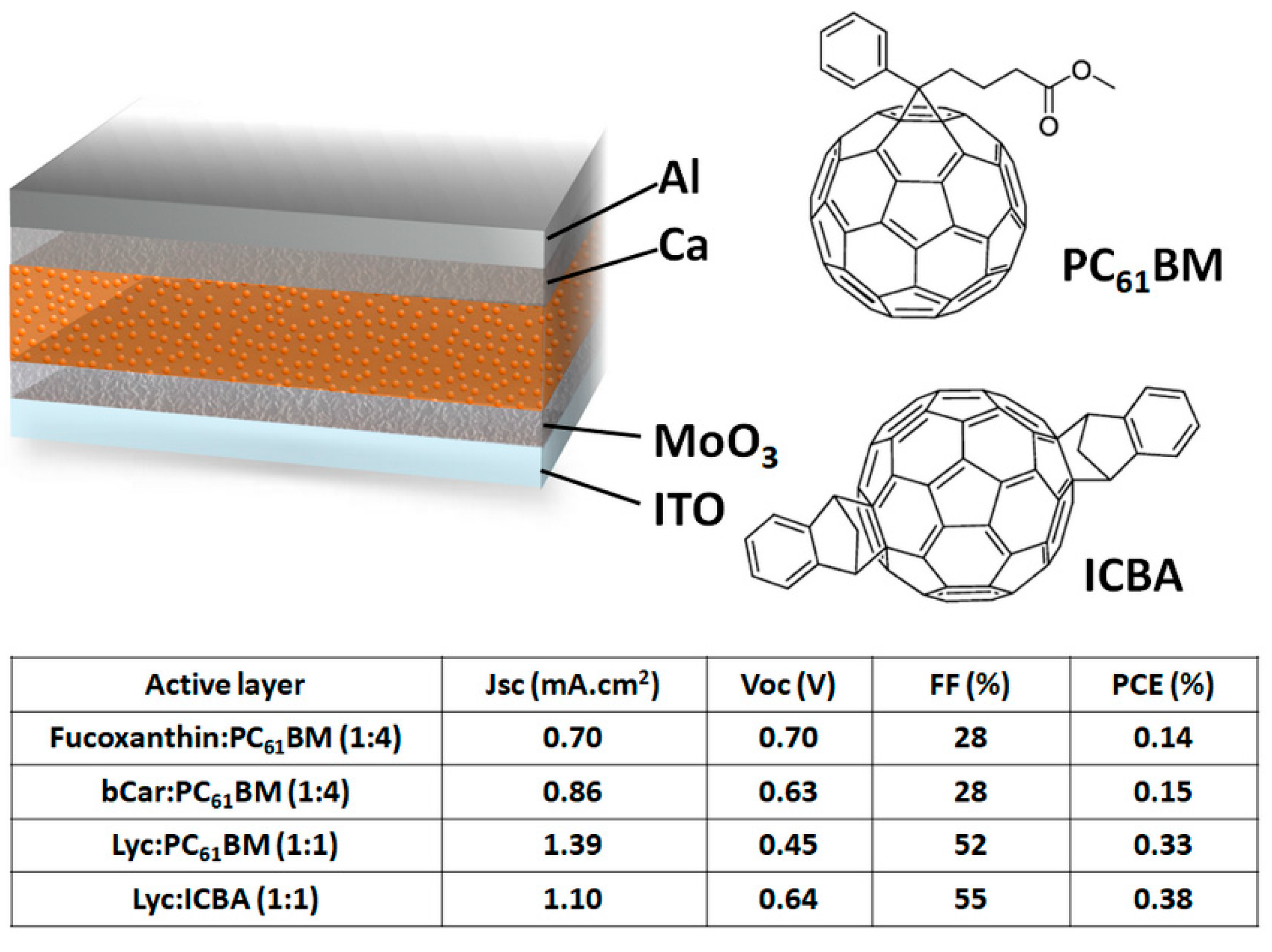
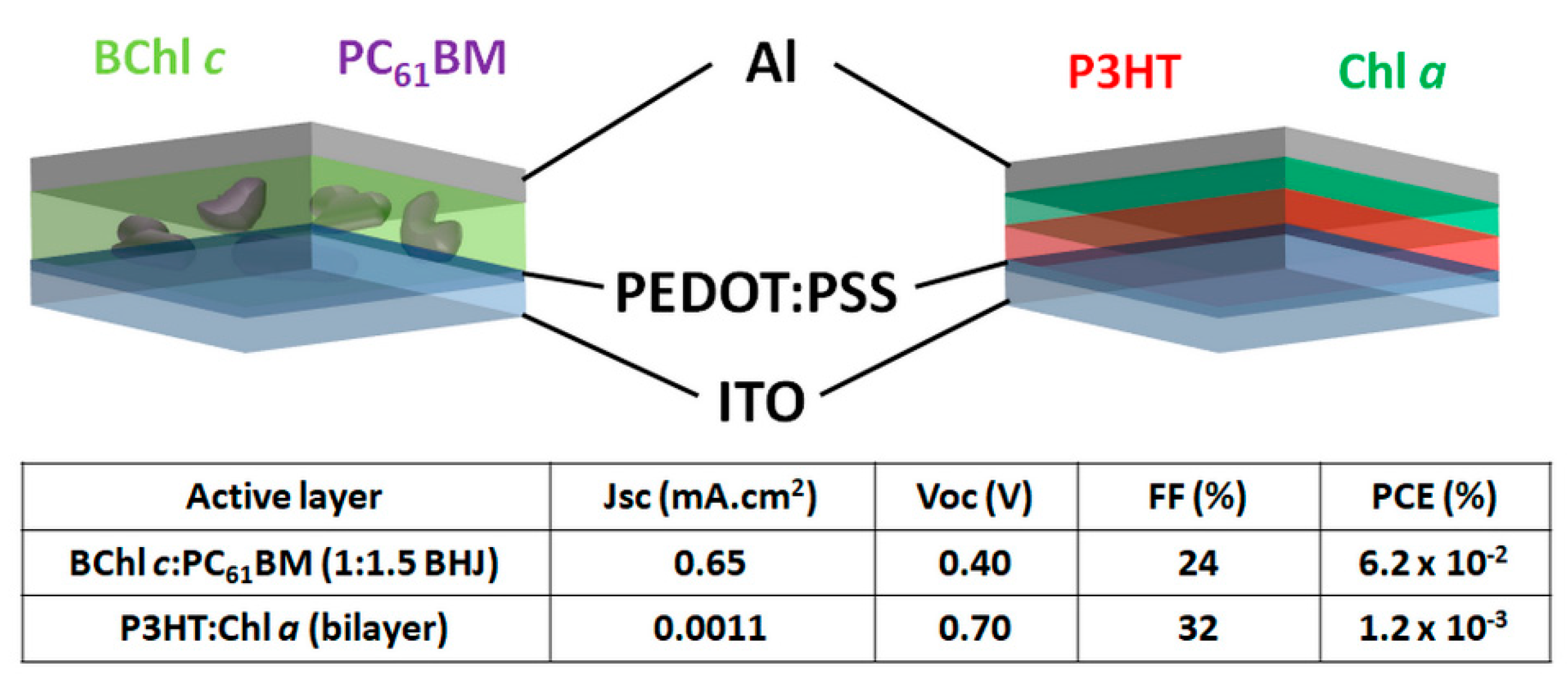
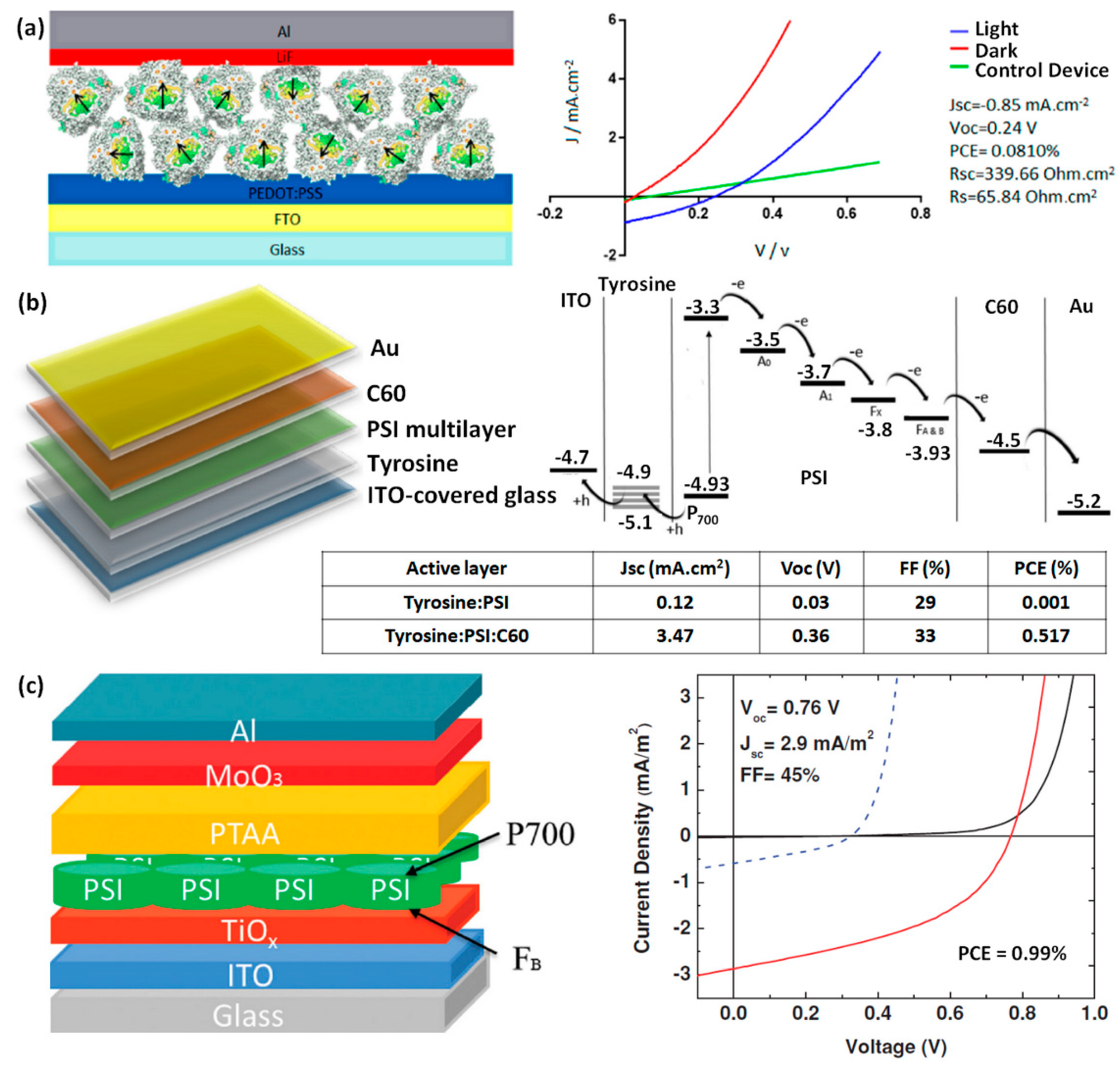
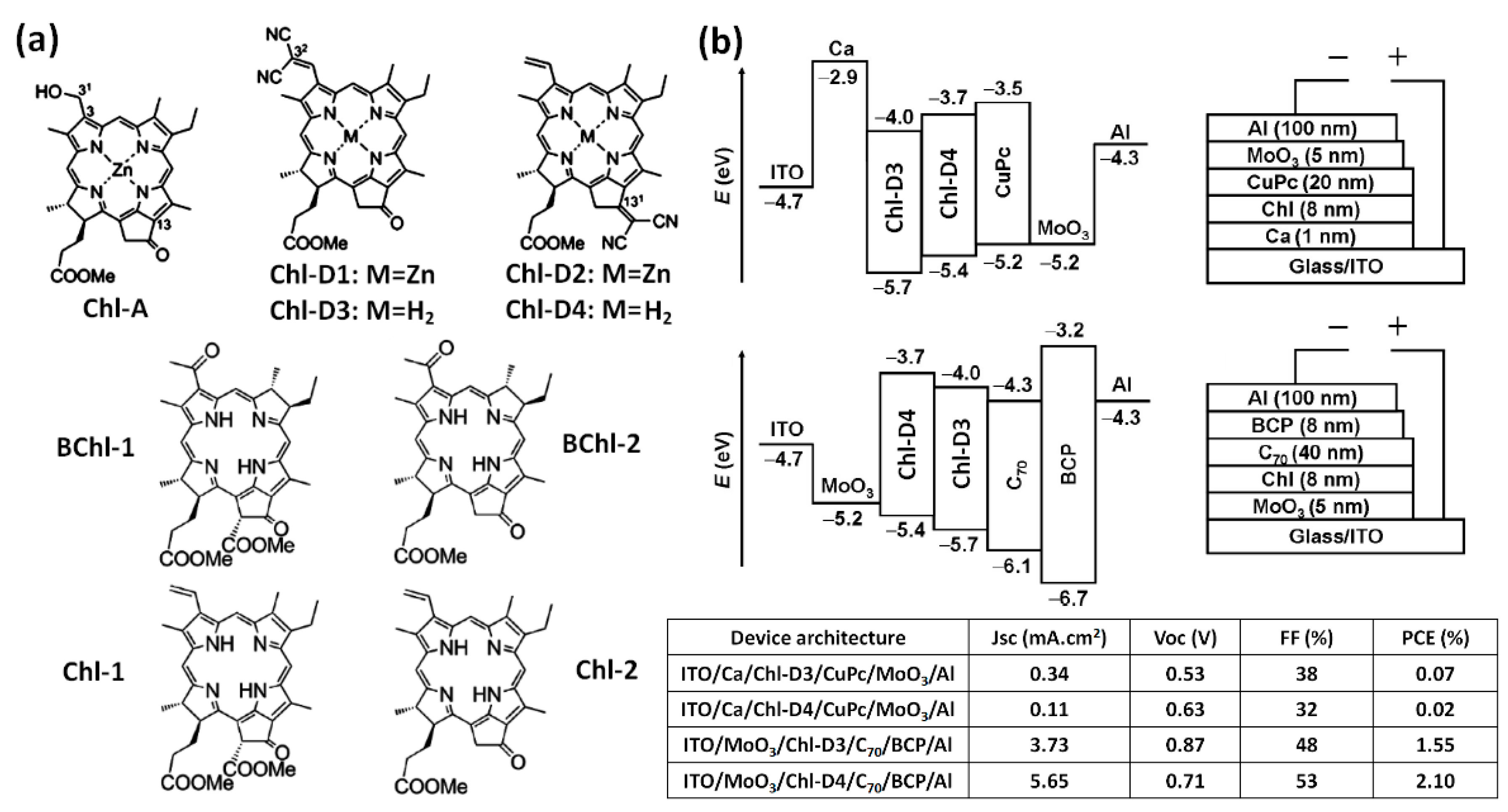
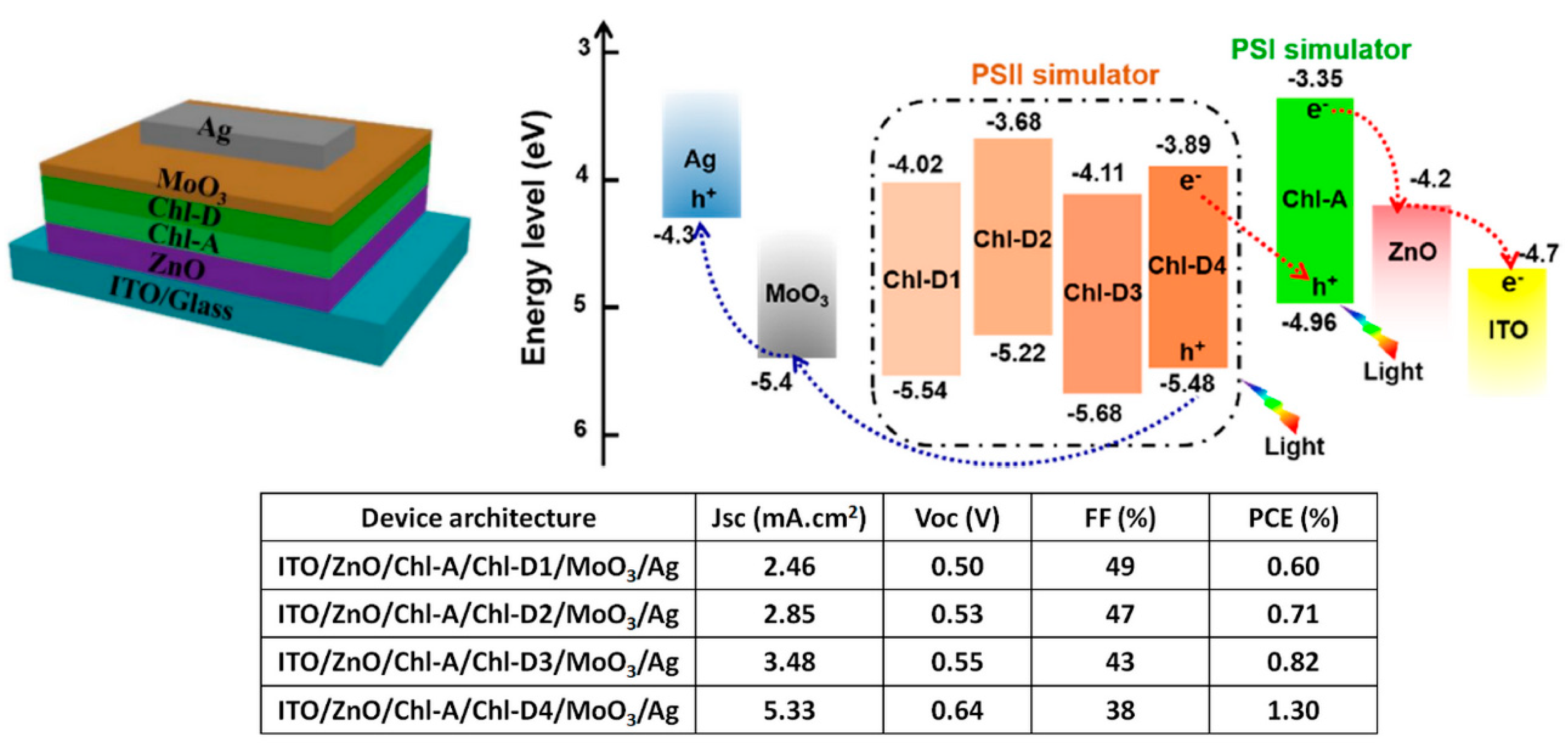

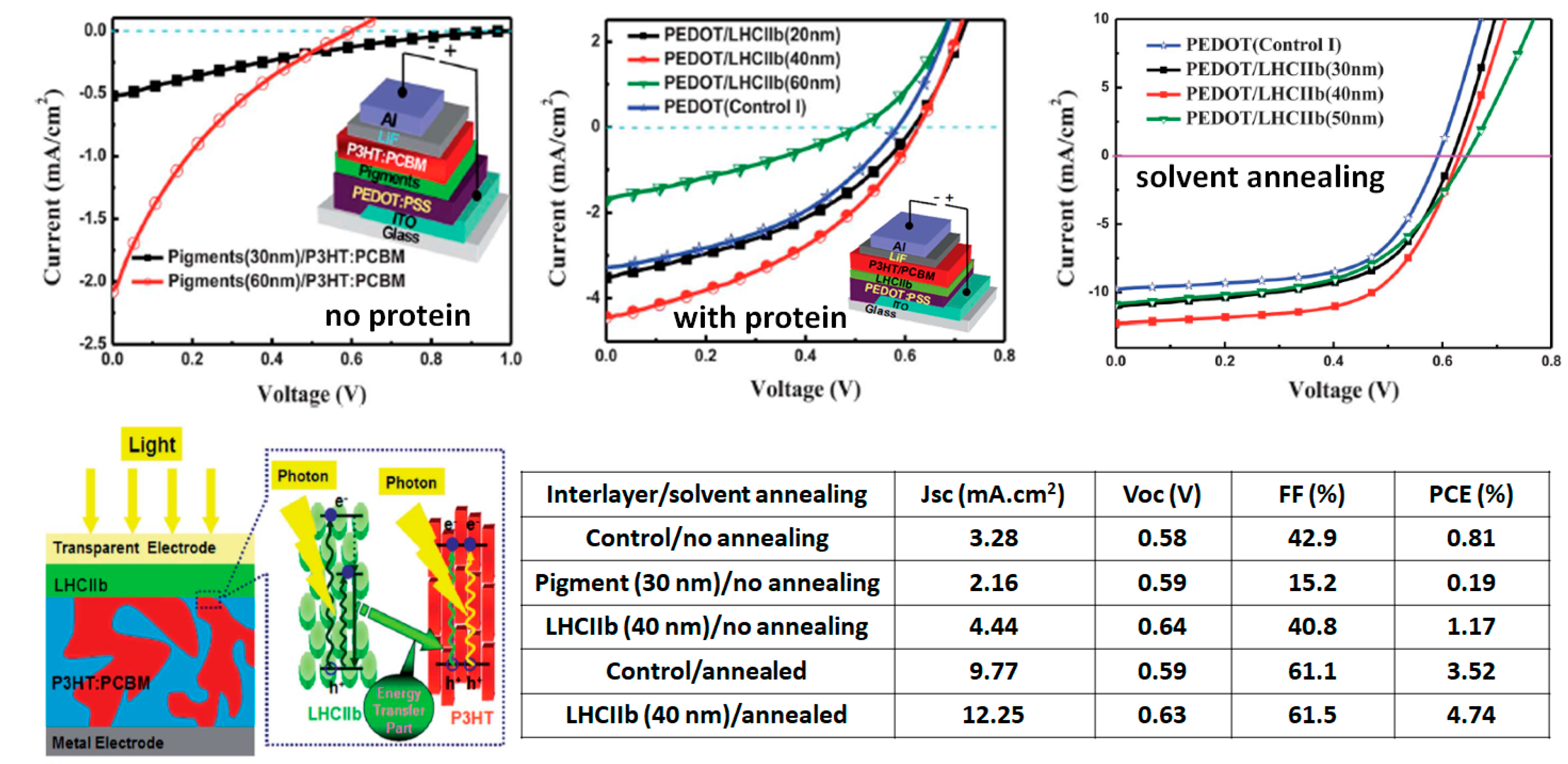
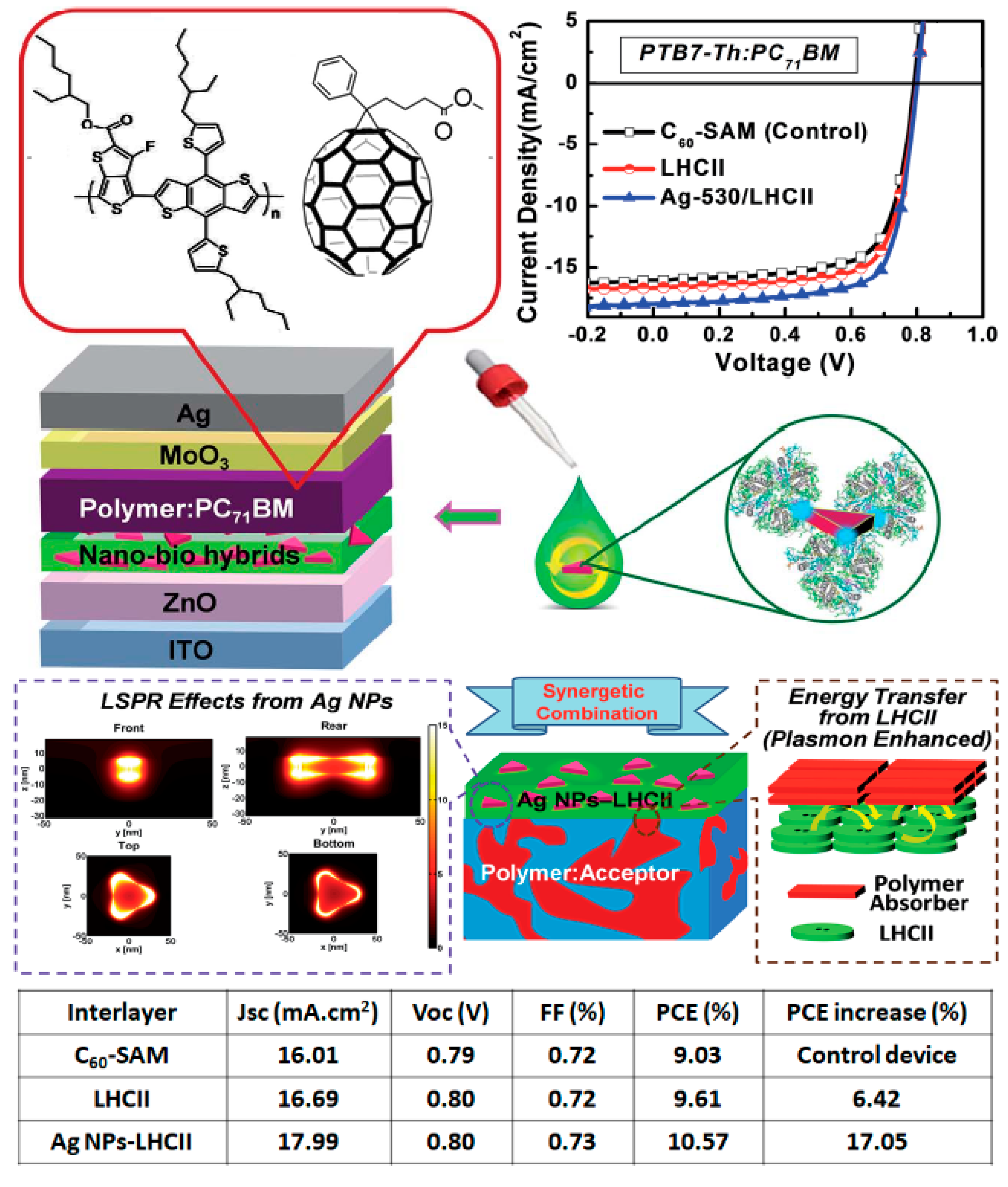
| “Natural” Material | Chemical Modifications | Function | Bottom Electrode; Top Electrode | Jsc (mA/cm2) | Voc (V) | FF (%) | PCE (%) |
|---|---|---|---|---|---|---|---|
| Carotenoids [20] | Natural (Lyc) | Electron donor | ITO/MoO3; Ca/Al | 1.1 | 0.64 | 55 | 0.38 |
| Carotenoids and Chl [22] | Natural (Lyc) and synthetic equivalent (Chl-D4) | Electron donor; electron acceptor | ITO/MoO3; Ca/Al | 0.23 | 0.85 | 23 | 0.05 |
| Chls [24] | Natural (Chla) | Electron acceptor | ITO/PEDOT:PSS; Al | 0.001 | 0.70 | 32 | 0.001 |
| Chls [23] | Natural (BChlc) | Electron donor | ITO/PEDOT:PSS; Al | 0.65 | 0.40 | 24 | 0.06 |
| Chl-D3 [33] | Synthetic equivalent of chlorophyll derivative | Electron acceptor | ITO/Ca; MoO3/Al | 0.34 | 0.53 | 38 | 0.07 |
| Chl-D4 [33] | Synthetic equivalent of chlorophyll derivative | Electron donor | ITO/MoO3; BCP/Al | 5.65 | 0.71 | 53 | 2.10 |
| Chl-A and Chl-D4 [35] | Synthetic equivalent of chlorophyll derivatives | Electron donor; electron acceptor | ITO/ZnO; MoO3/Ag | 5.33 | 0.64 | 38 | 1.30 |
| PSI [29] | Natural | Active layer | ITO/Tyrosine; C60/Au | 3.47 | 0.36 | 33 | 0.52 |
| PSI [32] | Natural | Active layer | ITO/TiOx; PTAA/MoO3/Al | 2.9 | 0.76 | 45 | 0.99 |
| Indigo [38] | Derivative | Electron acceptor | ITO/PEIE; MoOx/Ag | 0.2~0.5 | ~0.35 | - | <0.1 |
| Isoindigo [39] | Homopolymer | Electron acceptor | ITO/PEDOT:PSS; LiF/Al | 1.91 | 0.62 | 41 | 0.47 |
| Isoindigo [49] | Building block for p-type copolymer | Electron donor | ITO/PEDOT:PSS; Ca/Al | 14.4 | 0.79 | 72 | 8.05 |
| LHCIIb [54] | Natural | Antenna interlayer | ITO/PEDOT:PSS; LiF/Al | 12.3 | 0.63 | 62 | 4.74 |
| LHCII [55] | Natural | Antenna interlayer | ITO/ZnO; MoO3/Ag | 16.7 | 0.80 | 72 | 9.6 |
| LHCII [55] | Modified with Ag NPs | Plasmonic interlayer | ITO/ZnO; MoO3/Ag | 18.0 | 0.80 | 73 | 10.6 |
© 2018 by the author. Licensee MDPI, Basel, Switzerland. This article is an open access article distributed under the terms and conditions of the Creative Commons Attribution (CC BY) license (http://creativecommons.org/licenses/by/4.0/).
Share and Cite
Vohra, V. Natural Dyes and Their Derivatives Integrated into Organic Solar Cells. Materials 2018, 11, 2579. https://doi.org/10.3390/ma11122579
Vohra V. Natural Dyes and Their Derivatives Integrated into Organic Solar Cells. Materials. 2018; 11(12):2579. https://doi.org/10.3390/ma11122579
Chicago/Turabian StyleVohra, Varun. 2018. "Natural Dyes and Their Derivatives Integrated into Organic Solar Cells" Materials 11, no. 12: 2579. https://doi.org/10.3390/ma11122579
APA StyleVohra, V. (2018). Natural Dyes and Their Derivatives Integrated into Organic Solar Cells. Materials, 11(12), 2579. https://doi.org/10.3390/ma11122579





